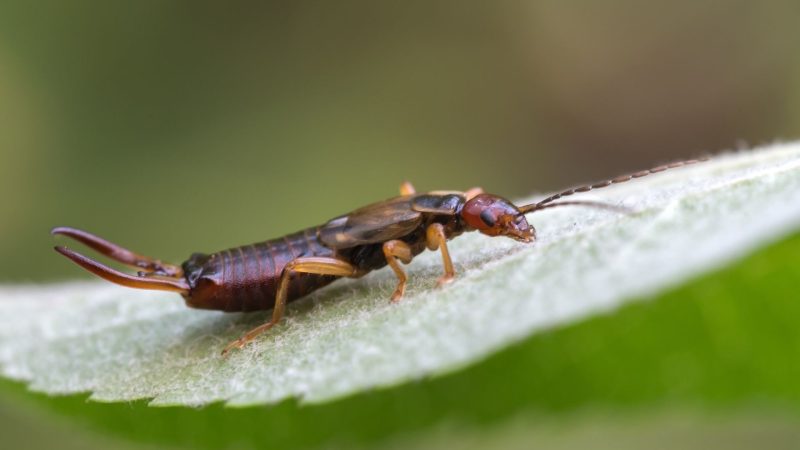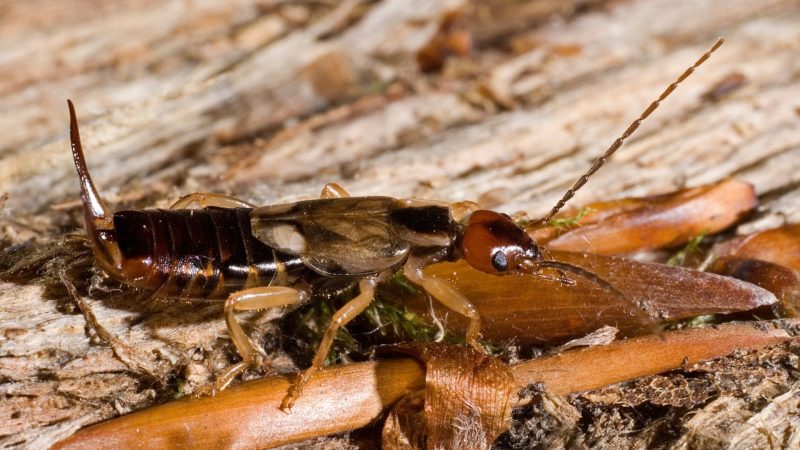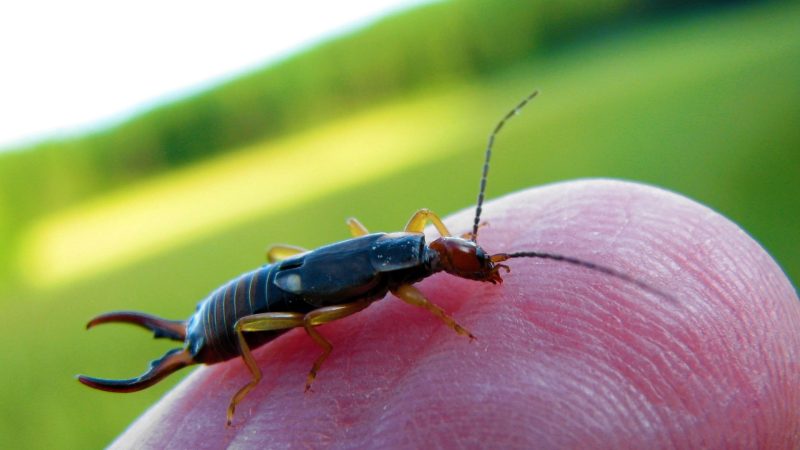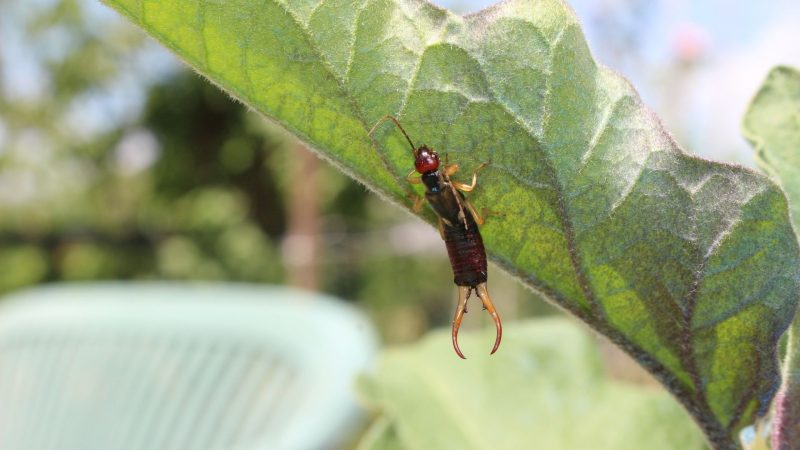Pincher bugs (also known as earwigs) don’t cause damage to structures and properties. However, having lots of them in your house can be annoying. They can also be both beneficial insects and garden pests at the same time. But still, you should get rid of them at once and prevent them from entering your house.
How to get rid of pincher bugs? To get rid of pincher bugs, remove their hidden places, remove excess moisture in your garden, and seal entry points to your house. If they are inside your home, you can trap them, use a vacuum cleaner, or sweep them out.
There are about 2,000 species of pincher bugs spread around the world, except in Antarctica. However, the most common species in North America is the European earwig, scientifically known as Forficula auricularia. But before you can get rid of them, you should know their appearance, habitat, and eating behaviors.
What Are Pincher Bugs?

Pincher bugs belong to the small insect order of Dermaptera. They are adaptable to working solo and in groups. Nevertheless, they don’t create a colony, and they don’t have a queen. Contrary to old beliefs, earwigs don’t crawl into human ears and lay eggs. In fact, earwigs rarely attack people.
Young and adult pincher bugs have a pair of prominent pincers (called cerci) at the end of their body, hence their name. They use these pinchers to grab and hold prey and sometimes, as a defense mechanism. However, they cannot squeeze objects hard enough. Baby earwigs have slender and straight pincers.
On the other hand, male earwigs have somewhat curved pincers, while females have straight pincers that are close together. Adult pincher bugs are usually reddish-brown and are about 3/4 in (19 mm) long. Earwig nymphs look the same as adults but are smaller. Juveniles have lighter colors than adults.
Where Do Pincher Bugs Come From?
As the name suggests, European earwig came from Europe and was accidentally introduced in the US back in the early 1900s. They live under the rocks, fallen trees, woodpiles, trash, or other damp, shady places. Pincher bugs travel by hitchhiking on luggage, fruit baskets, lumber, newspapers, vehicles, etc.
What Do Pincher Bugs Do?

Pincher bugs are nocturnal insects, which means that they are most active at night. During the day, earwigs sleep or hide in cold, dark, and moist places. In the outdoors, they are usually found in leaves and under potted plants. During the fall and winter seasons, females dig cells in the ground where they lay eggs.
But when summer comes, earwigs usually enter homes and buildings. They are not social insects, but a single earwig does not usually stay alone indoors. On the other hand, they invade homes in huge numbers. Earwigs don’t reproduce indoors. However, you can find lots of them in cold areas in your house.
What Do Pincher Bugs Eat?
Pincher bugs are generally omnivorous foragers, which means they eat plants and animals. Although their favorite diet is rotting plants, they also eat healthy plant material, weakened or dead insects, aphids, grubs, armyworms, maggots, and insect eggs. In short, earwigs feed on anything readily available to them.
Do Pincher Bugs Fly?

Pincher bugs have two pairs of wings – the forewings and the hindwings. Their front wings are short, scale-like, and appear to act as covers for their hindwings. On the other hand, their hindwings are fan-shaped and very thin. And although earwigs can fly, they usually fly in short bursts only. Instead, they prefer to crawl.
What Attracts Pincher Bugs?
Pincher bugs are very attracted to lights and excess moisture. The brighter the lights are, the more attractive they are for earwigs. Earwigs may also invade your house once they spot leaky faucets and pipes around air-conditioning units and other condensed crawl spaces. In the garden, they are most attracted to aphids.
Do Pincher Bugs Pinch?
Pincher bugs pinch humans. As mentioned earlier, they have pinchers at the end of their bodies to defend themselves. Earwigs may pinch you if you disturb them. But don’t worry, they pinch slightly and will not break your skin. However, it may leave a small bruise, so don’t pick them up with your bare hands.
Are Pincher Bugs Poisonous?
Pincher bugs may look dangerous, but actually, they’re not. They may only bite people when they are disturbed or threatened. Pincher bugs don’t sting people, and they don’t carry diseases. But, they emit a foul-smelling liquid from their scent glands to protect themselves from predators.
Once attacked, shore earwigs (Labidura riparia) spit a vile-smelling substance containing dimethyl trisulfide and dimethyl disulfide. Large amounts of these sulfur-based compounds are potentially hazardous. Fortunately, spits from a single earwig may cause mild irritation on the skin and are not poisonous.
Are Pincher Bugs Bad for Gardens?

Pincher bugs are bad for gardens. They primarily feed on aphids and soft-bodied pest insects, but they also chew irregular holes in flower blossoms and leaves. Earwigs cause substantial damage to seedlings, vegetables, flowering plants, and soft fruit trees, such as blackberries, strawberries, and raspberries.
Earwigs also prevent pollination in corns, causing seeds to develop very poorly. However, damages to plants may be similarly caused by caterpillars. On the other hand, pincher bugs are very unlikely to kill hard fruits, including apples, oranges, and grapes. They also rarely attack mature ornamental plants and grassy areas.
How to Get Rid of Pincher Bugs in the Garden?
Pincher bugs are garden pests. But since they also provide benefits to gardens, you should avoid killing them. As mentioned above, there are many ways to get rid of pincher bugs in the garden. All of them are effective, but they may work differently, depending on the severity of the problem. Here are some of them:
1. Minimize Their Habitat
Earwigs love to breed in soil and dark spaces under landscape stones. They may also be found in surface moisture levels, especially during the day. Below are the easiest effective ways to drive pincher bugs out of your garden:
- Make your garden dry for a while. In doing so, pincher bugs will move out little by little to find another place.
- Reducing earwig habitats also includes removing debris under the trees, thinning out of mulch, and making sure that water flows smoothly on sprouts and rain gutters.
- In trees, scrape off all loose barks, and treat trunks with a sticky substance that can prevent pincher bugs from climbing to the fruits and stems.
2. Install Traps
When installing traps, tuna, cat food, fish oil, and vegetable oil are among the ideal choices for your bait. To do this:
Step 1: You can place it on newspapers, cardboard, or other materials that can serve as their temporary shelters. Place as many traps as you can in your garden. For best results, install them at night when earwigs are most active.
Step 2: Check the trap early in the morning for a possible sight of pincher bugs in clusters.
Step 3: Collect the earwigs carefully, put them in a sealed bag, and leave them away from your garden.
Step 4: If you prefer using cans instead of newspapers, bury them into the ground but leave the top of the cans at soil level to attract more pincher bugs.
Here is a video on how to trap earwigs:
3. Create Barriers
To prevent pincher bugs from crawling to your plants, you can do the following:
- Put sticky barriers such as duct tapes around the stems.
- You may also lay some bamboo sticks or your garden hose so they cannot pass through.
- Earwigs also hate passing through dry areas. Therefore, add some gravel or sand to your garden.
- Glue barriers can also repel earwigs. Here, horticultural glue is placed in a waterproof band that you will wrap around the tree.
Meanwhile, to avoid earwigs from entering your house, seal all possible entry points. Repair wall cracks, broken windows and replace leaky faucets. Also, minimize moisture inside your house.
How to Get Rid of Earwigs (Pincher Bugs) Naturally?
Aside from the strategies mentioned above, here are some natural ways to get rid of earwigs:
- Since they are attracted to lights, use sodium vapor light bulbs for your outdoor lighting.
- Remove all decaying plant matters in your garden and indoor plants.
- Mix 70% concentration alcohol and water with equal amounts. Spray the mixture in infested areas.
- Spray a mixture of soap and water on the leaves.
- Spread petroleum jelly on the stems of your plants. However, large amounts may also destroy your plants.
- Trim or cut heavy ground covers that are near your gardens.
- Have some birds, lizards, and toads in your garden. They are the prime predators of earwigs.
What Kills Pincher Bugs?

If pincher bugs have already infested your garden, or they have invaded your home in large quantities, you may have no other choice but to eradicate them. Aside from predators, here are some of the effective ways to kill earwigs:
- Sprinkle the boric acid powder in hard-to-reach areas. However, this is poisonous to pets and humans when swallowed.
- Place some Diatomaceous earth (DE) around the base of your plant. Note, however, that DE is not effective during wet seasons.
- White vinegar and apple cider vinegar can kill pincher bugs. Spray them on these garden pests directly. However, it can also kill plants.
- Prepare a mixture of soy sauce in a small container near an infested area. Pincher bugs will crawl into it, and they will drown.
- Use organic pesticides such as spinosad and pyrethrins. They can kill earwigs without harming your plants and pets.
- If they are on the floor inside your house, use a vacuum cleaner to suck them to death. For outdoors, such as your garden, use a portable vacuum.
Summary
If the earwig infestation is severe, you should combine some of the strategies above to produce better results. Some methods alone don’t usually work effectively during treatment. Meanwhile, some of the techniques are harmful to plants in your garden. Therefore, you must try first on one portion of your garden and observe the result before using them in full blast.
Related: Earwig Control: How To Get Rid of Earwigs?
List of Sources
Hahn, J., Pellitteri, P. (2019). Earwigs. University of Minnesota.
Flint, M. (2012). How to Manage Pests – Pests in Gardens and Landscapes: Earwigs. University of California.
Shetlar, D., Andon, J. (2010). Earwigs. Ohio State University.
Don’t Wig Out Over Earwigs. Iowa State University
Waldvogel, M., Alder, P. (2008). Household Pests: Earwigs. NC State University.
- How to Get Rid of Copperheads | Practical Guide - August 27, 2023
- How to Get Rid of Corn Snakes | What Makes Them Aggressive? - August 27, 2023
- How to Get Rid of Alligators | Safety Measures and Removal Methods - July 16, 2023
